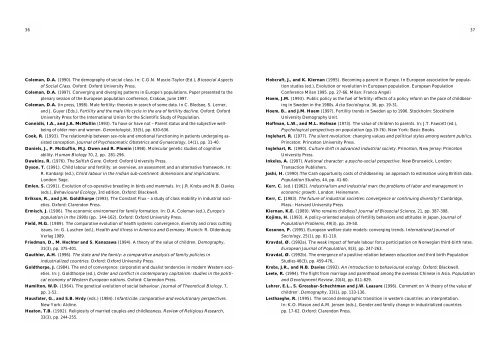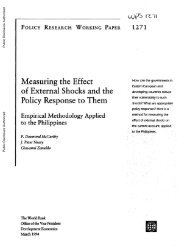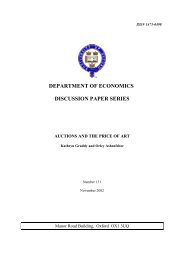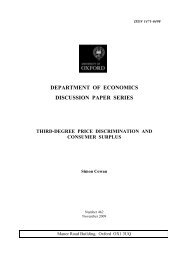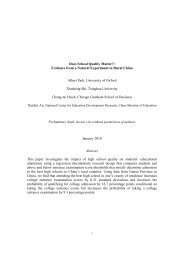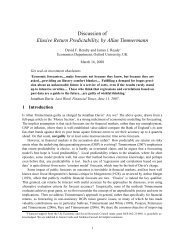Item.pdf - University of Oxford
Item.pdf - University of Oxford
Item.pdf - University of Oxford
Create successful ePaper yourself
Turn your PDF publications into a flip-book with our unique Google optimized e-Paper software.
36<br />
Coleman, D.A. (1990). The demography <strong>of</strong> social class. In: C.G.N. Mascie-Taylor (Ed.), Biosocial Aspects<br />
<strong>of</strong> Social Class. <strong>Oxford</strong>: <strong>Oxford</strong> <strong>University</strong> Press.<br />
Coleman, D.A. (1997). Converging and diverging patterns in Europe’s populations. Paper presented to the<br />
plenary session <strong>of</strong> the European population conference, Crakow, June 1997.<br />
Coleman, D.A. (in press, 1998). Male fertility: theories in search <strong>of</strong> some data. In C. Bledsoe, S. Lerner,<br />
and J. Guyer (Eds.), Fertility and the male life cycle in the era <strong>of</strong> fertility decline. <strong>Oxford</strong>: <strong>Oxford</strong><br />
<strong>University</strong> Press for the International Union for the Scientific Study <strong>of</strong> Population.<br />
Connidis, I.A., and J.A. McMullin (1993). To have or have not – Parent status and the subjective wellbeing<br />
<strong>of</strong> older men and women. Gerontologist, 33(5), pp. 630-636.<br />
Cook, R. (1993). The relationship between sex-role and emotional functioning in patients undergoing assisted<br />
conception. Journal <strong>of</strong> Psychosomatic Obstetrics and Gynaecology, 14(1), pp. 31-40.<br />
Daniels, J., P. McGuffin, M.J. Owen and R. Plomin (1998). Molecular genetic studies <strong>of</strong> cognitive<br />
ability. Human Biology 70, 2, pp. 281-296.<br />
Dawkins, R. (1976). The Selfish Gene. <strong>Oxford</strong>: <strong>Oxford</strong> <strong>University</strong> Press.<br />
Dyson, T. (1991). Child labour and fertility: an overview, an assessment and an alternative framework. In:<br />
R. Kanbargi (ed.), Child labour in the Indian sub-continent: dimensions and implications.<br />
London: Sage.<br />
Emlen, S. (1991). Evolution <strong>of</strong> co-operative breeding in birds and mammals. In: J.R. Krebs and N.B. Davies<br />
(eds.), Behavioural Ecology, 3rd edition, <strong>Oxford</strong>: Blackwell.<br />
Erikson, R., and J.H. Goldthorpe (1993). The Constant Flux – a study <strong>of</strong> class mobility in industrial societies.<br />
<strong>Oxford</strong>: Clarendon Press.<br />
Ermisch, J. (1996). The economic environment for family formation. In: D.A. Coleman (ed.), Europe’s<br />
population in the 1990s (pp. 144-162). <strong>Oxford</strong>: <strong>Oxford</strong> <strong>University</strong> Press.<br />
Field, M.G. (1989). The comparative evolution <strong>of</strong> health systems: convergence, diversity and cross cutting<br />
issues. In: G. Luschen (ed.), Health and illness in America and Germany. Munich: R. Oldenburg<br />
Verlag 1989.<br />
Friedman, D., M. Hechter and S. Kanazawa (1994). A theory <strong>of</strong> the value <strong>of</strong> children. Demography,<br />
31(3), pp. 375-401.<br />
Gauthier, A.H. (1996). The state and the family: a comparative analysis <strong>of</strong> family policies in<br />
industrialized countries. <strong>Oxford</strong>: <strong>Oxford</strong> <strong>University</strong> Press.<br />
Goldthorpe, J. (1984). The end <strong>of</strong> convergence: corporatist and dualist tendencies in modern Western societies.<br />
In: J. Goldthorpe (ed.), Order and conflict in contemporary capitalism: studies in the political<br />
economy <strong>of</strong> Western European nations. <strong>Oxford</strong>: Clarendon Press.<br />
Hamilton, W.D. (1964). The genetical evolution <strong>of</strong> social behaviour. Journal <strong>of</strong> Theoretical Biology, 7,<br />
pp. 1-52.<br />
Hausfater, G., and S.B. Hrdy (eds.) (1984). Infanticide: comparative and evolutionary perspectives.<br />
New York: Aldine.<br />
Heaton, T.B. (1992). Religiosity <strong>of</strong> married couples and childlessness. Review <strong>of</strong> Religious Research,<br />
33(3), pp. 244-255.<br />
Hobcraft, J., and K. Kiernan (1995). Becoming a parent in Europe. In European association for population<br />
studies (ed.), Evolution or revolution in European population. European Population<br />
Conference Milan 1995. pp. 27-66. Milan: Franco Angeli<br />
Hoem, J.M. (1993). Public policy as the fuel <strong>of</strong> fertility: effects <strong>of</strong> a policy reform on the pace <strong>of</strong> childbearing<br />
in Sweden in the 1980s. Acta Sociologica, 36, pp. 19-31.<br />
Hoem, B., and J.M. Hoem (1997). Fertility trends in Sweden up to 1996. Stockholm: Stockholm<br />
<strong>University</strong> Demography Unit.<br />
H<strong>of</strong>fman, L.W., and M.L. H<strong>of</strong>man (1973). The value <strong>of</strong> children to parents. In: J.T. Fawcett (ed.),<br />
Psychological perspectives on population (pp.19-76). New York: Basic Books.<br />
Inglehart, R. (1977). The silent revolution: changing values and political styles among western publics.<br />
Princeton: Princeton <strong>University</strong> Press.<br />
Inglehart, R. (1990). Culture shift in advanced industrial society. Princeton, New Jersey: Princeton<br />
<strong>University</strong> Press.<br />
Inkeles, A. (1997). National character: a psycho-social perspective. New Brunswick, London:<br />
Transaction Publishers.<br />
Joshi, H. (1990).The Cash opportunity costs <strong>of</strong> childbearing: an approach to estimation using British data.<br />
Population Studies, 44, pp. 41-60.<br />
Kerr, C. (ed.) (1962). Industrialism and industrial man: the problems <strong>of</strong> labor and management in<br />
economic growth. London: Heinemann.<br />
Kerr, C. (1983). The future <strong>of</strong> industrial societies: convergence or continuing diversity? Cambridge,<br />
Mass.: Harvard <strong>University</strong> Press<br />
Kiernan, K.E. (1989). Who remains childless? Journal <strong>of</strong> Biosocial Science, 21, pp. 387-398.<br />
Kojima, H. (1993). A policy-oriented analysis <strong>of</strong> fertility behaviors and attitudes in Japan. Journal <strong>of</strong><br />
Population Problems, 49(3), pp. 29-50.<br />
Kosonen, P. (1995). European welfare state models: converging trends. International Journal <strong>of</strong><br />
Sociology, 25(1), pp. 81-110.<br />
Kravdal, Ø. (1992a). The weak impact <strong>of</strong> female labour force participation on Norwegian third-birth rates.<br />
European Journal <strong>of</strong> Population, 8(3), pp. 247-263.<br />
Kravdal, Ø. (1992b). The emergence <strong>of</strong> a positive relation between education and third birth Population<br />
Studies 46(3), pp. 459-476,.<br />
Krebs, J.R., and N.B. Davies (1993). An introduction to behavioural ecology. <strong>Oxford</strong>: Blackwell.<br />
Leete, R. (1994). The flight from marriage and parenthood among the overseas Chinese in Asia. Population<br />
and Development Review, 20(4), pp. 811-829.<br />
Lehrer, E.L., S. Grossbar-Schechtman and J.W. Leasure (1996). Comment on ‘A theory <strong>of</strong> the value <strong>of</strong><br />
children’. Demography, 33(1), pp. 133-136.<br />
Lesthaeghe, R. (1995). The second demographic transition in western countries: an interpretation.<br />
In: K.O. Mason and A.M. Jensen (eds.), Gender and family change in industrialized countries<br />
pp. 17-62. <strong>Oxford</strong>: Clarendon Press.<br />
37


